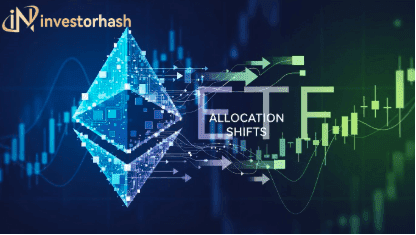How the Fed's Next Move Could Shake Up Crypto Markets
The Federal Reserve is set to announce its latest interest rate decision on Wednesday, an event that while not likely to directly impact � prices, could have ripple effects based on the central bank's economic outlook and future policy plans.
This latest rate verdict comes amid crushing inflation and fears of a looming recession. While the Fed is expected to hold rates steady this time, its accompanying rhetoric and signals about its broader trajectory could send shockwaves across stock and crypto markets.
This article will deliver the key details around the rate decision, provide expert analysis on potential market impacts, share the author's objective opinion, deliver a Bitcoin commentary, make a prediction, draw historical parallels, and answer pressing questions on the Fed and crypto markets.
Fed Poised to Pause Rate Hikes After Aggressive Tightening
After a year of substantial rate increases intended to rein in soaring inflation, the Fed is ready to pause its hikes, at least temporarily. Its aggressive policy tightening has already pushed rates from near-zero in March 2022 to around 5.5% currently.
With growing concerns about an economic downturn, the Fed appears inclined to halt rate rises for now to assess their impact. Its decision will arrive after a pivotal two-day Federal Open Market Committee (FOMC) meeting concluding Wednesday.
While the rate verdict itself may already be priced in, the Fed's tone and any hints at future policy could spark significant market swings. Its remarks will be scrutinized for evidence of a policy pivot or any suggestion rates may near their peak.
Nuanced Messaging Could Sway Stocks and Crypto
Expert analysts concur the rate decision will likely minimally impact crypto markets directly. However, nuances in the Fed's communication could produce outsized market effects.
If the Fed hints rates are topping out or strikes a dovish tone, bitcoin and stock prices could rally. But hawkish messaging could conversely sink markets. Markets seem more reactive currently to SEC actions than Fed policy, but central bank signaling still carries weight.
Beyond rates, anytimeline for stopping quantitative tightening could buoy markets. And suggestions of nearing recession could spark a risk-off environment. With crypto following stock market trends, cautious positioning is prudent around such influential events.
Opinion: Markets Need Clarity on Where Rates are Headed
In this commentator's view, uncertainty over the destination of rates is currently overshadowing markets. The Fed's communications must provide clearer guideposts on rate trajectory or risk extended volatility.
Are we near the end of this post-pandemic "economic war" as one analyst suggested? Or will restrictive policies need to persist well into 2023? The Fed must level with markets to instill confidence. Its remarks will set the tone for asset prices in coming months.
Delivering a credible forecast on rates and inflation would be welcomed by investors hungry for direction. The Fed must also be alert to any overtightening that could trigger severe economic fallout. If a pivot does loom, signaling it early could calm markets. But surprise shifts could sow chaos.
Above all, markets require transparency on the Fed's thinking to price risk accordingly. Its communication missteps this year have sown distrust. Restoring its credibility now is paramount.
Bitcoin Provides Freedom from Government Monetary Manipulation
While the Fed works to rectify its policy mistakes, truly free markets like Bitcoin offer an alternative. Bitcoin's decentralized design frees it from centralized control like government money printing.
Unlike fiat cash vulnerable to debasement by inflationary policies, Bitcoin's supply is immutable. This shields users from hidden taxes by reduced purchasing power. And its independence from oversight curbs assets being wrongfully frozen or seized.
In a world of government overreach, Bitcoin provides individuals financial autonomy. As faith in institutions like central banks wanes, Bitcoin's appeal strengthens. And amid market turbulence, it offers uncorrelated shelter as the Fed fuels volatility.
Prediction: The Fed Will Signal a Rate Pause Through 2023
This columnist forecasts the Fed will clearly telegraph a prolonged pause to its rate hike agenda through 2023. With the full impact of existing tightening still unfolding, it will opt to stand pat at coming meetings to gauge results.
Rates will likely plateau around 5% absent a dramatic growth or inflation surprise. Quantitative tightening will continue but be slowed or suspended if markets deteriorate. A protective Fed wants to avoid a hard landing.
While pausing hikes, it will keep the door open to restarting them if data warrants. But an extended reprieve from further tightening seems the likely path. The Fed will take care to issue consistent guidance to restore confidence.
Historical Echoes: 1970s Stagflation, 1937 Recession, 1927 Bubble
There are echoes in today's environment of several volatile historical episodes. In the 1970s, the Fed hit the brakes too hard, triggering recession and prolonged stagflation. In 1937, tightened policy sparked another downturn right as recovery took hold.
And in 1927, the Fed dismissed rampant stock speculation, only to see markets crater in 1929. Its current predicament carries strains of each crisis - potentially overcorrecting policies, fragility after a crisis, and dismissing asset overvaluation.
Hopefully studying this monetary history can help the Fed navigate present turbulence with wisdom. But there are no guarantees today's officials will avoid a similar policy miscalibration.
Will Lower Rates Boost Crypto in the Long Run?
Lower rates traditionally boost risk assets like crypto. But in the current climate, that may not hold true. While paused hikes may offer short-term relief, ongoing quantitative tightening still removes liquidity from markets.
And extremely low rates after the 2020 crisis helped inflate speculative bubbles. So today's still historically high rates after massive tightening may restrict upside for some time. Macro conditions and regulation will likely overshadow rates alone in driving crypto.
If inflation is tamed, growth stabilizes, and clarity emerges on policy limits, crypto could prosper even in a 5-6% rate environment. But if volatility persists, crypto will struggle regardless of where rates settle. The context around rates matters more than the absolute level.
How Will Policy Shifts Impact Bitcoin vs Altcoins?
Bitcoin's status as digital gold means it often reacts differently than altcoins to policy changes. Its hedge appeal draws inflows during turmoil. Rate cuts may aid speculative altcoins more by spurring risk appetite.
Conversely rate hikes can hit altcoins harder by elevating their relative risk. And bitcoin's liquidity makes it better suited to weather volatility. But altcoins offer higher upside potential if conditions improve.
Yet many macro factors affect both, and differences between assets are nuanced. Policy shifts don't alter bitcoin's long-term competitiveness against fiat. But near-term impacts vary. Understanding each asset's properties is key to navigating Fed actions.
In closing, the Fed faces immense pressure to thread the needle between recession and runaway inflation. This week's decision is just one milepost on that precarious path. While its rate verdict may be anticlimactic, the messaging surrounding it could set the tone for markets for months. As the Fed seeks to restore its credibility, crypto continues offering an alternative to government monetary intervention.




